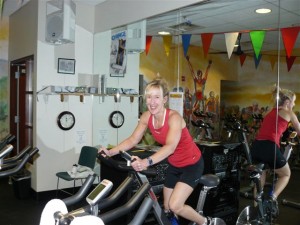Although some exercises are not recommended for certain types of asthma, those usually are performed outdoors where cold air or pollen irritates the bronchial passageways and may trigger an attack. There are many workouts that are approved for those with asthma and allergies, which actually help ease the associated discomfort.
A Common Misconception
Contrary to popular belief, those with asthma should not eliminate physical activity from their lives. True, some people suffer exercise-induced asthma year round. In actuality though, regular exercise, including aerobic, strengthens and conditions the lungs to make their work easier. Exercise also relieves stress and improves mental health, which can help alleviate chronic suffering.
Many athletes, including Olympic competitors, succeed despite their asthma. You can find them participating—and winning– in a variety of categories such as track and field, mountain biking, kayaking, cycling, and rowing. Controlling symptoms allows you to safely exert yourself, which in turn increases your overall functionality and quality-of-life.
Effective asthma treatment allows one to maintain an active, healthy lifestyle. With a physician-approved action plan, you can control symptoms and enjoy exercise. A combination of medication, monitoring symptoms and lung function, and identifying triggers can help determine your best exercise program.
Recommended Exercises
Think short bursts of exercise as opposed to long periods of exertion. Fitness experts indicate this type of workout is also more effective at getting into overall better shape. (See “Fast & Furious Fitness” published at https://fitnessandwellnessnews.com/?p=1183 on 4/16/10.) Aquatic workouts are ideal for asthma sufferers. The moist, warm air makes this a well-tolerated environment for a safe workout that produces excellent results.

On the Exercise Floor, use the cycles and the treadmill. Consider Group Fitness classes that are aerobic in nature. Also, classes that focus on breathing techniques are particularly beneficial. Breathing exercises have been proven to help relieve symptoms and reduce the amount of medication needed. T’ai Chi and Pilates coordinate breathing and movement to help build stamina and reduce discomfort. Research specifically indicates that T’ai Chi improves exercise endurance and performance for asthma sufferers.
Yoga teaches deep, slow breathing while providing exercise for the body and calm for the mind. Enjoyed by many, it is a holistic approach to reducing allergy and asthma symptoms. Relaxation techniques, common to the time-proven practice of yoga, aid in quieting the body’s immune system, which allows a decrease in the inflammation and mucus that can trigger attacks.
Practice smooth, relaxing yoga during peak asthma periods. Include plenty of slow breathing. Gary Kraftsow, author of Yoga for Wellness (Penguin, 1999), suggests emphasis on exhalation. He recommends a short inhalation followed by a longer one for a soothing effect. Standing poses are considered beneficial, including forward and backward bends and gentle twists. These tend to massage various parts of the spine and thoracic cage, and condition the lungs.
Take advantage of the pollen-free, clean air within the Center. A shower of petals looks like a pretty setting for a walk or run but can wreak havoc on your respiratory system and allergies. Poor outdoor air quality, like everyday pollution, can also be a trigger. If you choose to exercise outdoors, perhaps wear a face mask to warm and filter the air you breathe.
Before Beginning Your Workout
- Take your asthma medication. Use your pre-exercise asthma inhaler. Keep it with you during all times at the Center, advises Nurse Manager Margery Cottrell, RN.
- Perform an appropriate warm-up. This allows your body, including the respiratory system, smooth transitions. Fifteen minutes is recommended so lungs have ample time to adjust to the increased oxygen demand. And, don’t forget a proper cool-down of the same duration.
- Avoid exercise if you have a virus, especially one that involves congestion or a cough.
- Remain hydrated. At the first sign of needing to clear your throat, Margery recommends sipping some water. This may help offset a pending attack.
- Don’t overexert yourself. Go at your own pace. Follow your body’s signals to determine intensity and length.
- Alert your personal trainer and fitness instructors about your condition. Inform any workout buddies, as well. Support may be helpful in the event of an attack.
Overcoming an Asthma Attack while Exercising
Despite best efforts, sometimes an asthma attack is unavoidable. If this occurs while you’re exercising, remain calm. Use your inhaler to administer medication, which should be with you at all times during a workout. This should provide quick relief. If symptoms completely disappear, cautiously proceed with your workout. If they return, stop the activity and call your healthcare provider. The Center’s on-site Nursing department is available to help. With trained staff readily accessible, be assured we will assist you in getting the help needed if ever a health issue arises.

By following your physician-recommended treatment plan, and taking simple precautions, asthma and allergies should not prevent you from living a healthy, active life. The Center strives to accommodate members with diverse needs. Along with allergies and asthma, your exercise routine can peak this season, too.
Sources
“Allergies and Asthma: They Often Occur Together,” at www.mayoclinic.com.
“Allergy Antidote: Modifying Your Yoga Practice with Calming Poses Can Help You Breathe Easier,” Angela Pirisi, at www.yogajournal.com.
“Asthma Treatment: Do Complementary and Alternative Approaches Work?” at www.mayoclinic.com.
“Exercise and Asthma,” at www.webmd.com.
“Exercise-Induced Asthma,” at www.medicinenet.com.
Image Credits
Breathe heart (introduction picture): www.flickr.com/photos/shawnzlea.
Just breathe: www.flickr.com/photos/ethermoon.
 Fitness & Wellness News Your Source for Fitness News, Wellness News, Health News, and Nutrition News!
Fitness & Wellness News Your Source for Fitness News, Wellness News, Health News, and Nutrition News!



